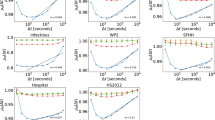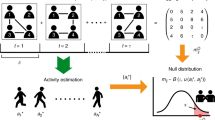Abstract
This article describes basic approaches for modeling of collaboration networks. We discuss typical ways of modeling collaboration networks and we also propose a new extension in weighting ties among event participants and the idea of aging of the ties among collaborators. Classical as well as proposed approaches to weighting of ties in collaboration networks are experimentally evaluated on real data set and compared with peoples’ opinions expressed in a targeted inquiry.
Access this chapter
Tax calculation will be finalised at checkout
Purchases are for personal use only
Preview
Unable to display preview. Download preview PDF.
Similar content being viewed by others
References
Newman, M.E.J.: Who is the best connected scientist? A study of scientific coauthorship networks. Complex Networks (2004)
Wasserman, S., Faust, K.: Social Network Analysis. Cambridge University Press, Cambridge (1994)
Davis, A., Gardner, B.B., Gardner, M.R.: Deep South. Anthropological Study of Caste and Class.University of Chicago Press, A social (1941)
Watts, D.J., Strogats, S.H.: Collective dynamics of ’small-world’ networks. Nature (1998)
Newman, M.E.J.: Scientific collaboration networks. II. Shortest paths, weighted networks, and centrality. The Amarical Physical Society 64 (2001)
DAK - Collaboration Network, data set of non-profit organization (2011), http://www.domcek.org
Opsahl, T.: Projecting two-mode networks onto weighted one-mode networks (2009)
Tutoky, G., Paralič, J.: Modelovanie a analýza malej komunitnej sociálnej siete. In: 5th Workshop on Intelligent and Knowledge oriented Techniloties, Bratislava (2010)
Tutoky, G., Repka, M., Paralič, J.: Structural analysis of social groups in colla-boration network. In: Faculty of Electrical Engineering and Informatics of the Technical University of Košice, Košice (2011)
Hajra, K.B., Sen, P.: Aging in citation networks. Elsevier Science, Amsterdam (2008)
Zhu, H., Wang, X., Zhu, J.-Y.: The effect of aging on network structure. The American Physical Society (2003)
Ebbinghaus, H.: Memory: A Contribution to Experimental Psychology. Teachers College, New York (1885)
Savara, S.: The Ebbinghaus Forgetting Curve – And How To Overcome It, http://sidsavara.com/personal-productivity/the-ebbinghaus-curve-of-forgetting
Kleinberg, J.M.: Authoritative Sources in a Hyperlinked Environment. In: ACM-SIAM Symposium on Discrete Algorithms (1998)
Batagelj, V., Mrvar, A.: Pajek - Program for Analysis and Visualization of Large Networks, Ljubljana (2009)
Author information
Authors and Affiliations
Editor information
Editors and Affiliations
Rights and permissions
Copyright information
© 2011 Springer-Verlag Berlin Heidelberg
About this paper
Cite this paper
Tutoky, G., Paralič, J. (2011). Time Based Modeling of Collaboration Social Networks. In: Jędrzejowicz, P., Nguyen, N.T., Hoang, K. (eds) Computational Collective Intelligence. Technologies and Applications. ICCCI 2011. Lecture Notes in Computer Science(), vol 6922. Springer, Berlin, Heidelberg. https://doi.org/10.1007/978-3-642-23935-9_40
Download citation
DOI: https://doi.org/10.1007/978-3-642-23935-9_40
Publisher Name: Springer, Berlin, Heidelberg
Print ISBN: 978-3-642-23934-2
Online ISBN: 978-3-642-23935-9
eBook Packages: Computer ScienceComputer Science (R0)




